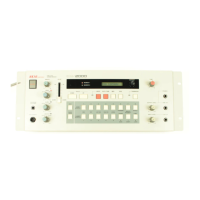
Do you have a question about the Akai EWV2000 and is the answer not in the manual?
| Frequency Response | 20 Hz - 20 kHz |
|---|---|
| Compatibility | Akai EWI wind controllers |
| Inputs | EWI Input |
| Outputs | Stereo Out |
| Power Supply | 12V DC Adapter |
| Included Accessories | AC Adapter, Owner's Manual |
Covers power requirements, voltage selection, shock prevention, and UK wiring.
Details safe usage, ventilation, cleaning, and lithium battery warning.
Highlights 2-system analog synth, memory banks, and expression via sensors.
Mentions MIDI, LCD, tape interface, and polyphonic playback.
Details POWER, PROGRAM UP/DOWN, INSTRUMENT connections.
Explains VIBRATE, BEND, GLIDE, BREATH, VALUE controls.
Covers DISPLAY, SOURCE LEDs, CONTRAST, WRITE, AUTO TUNE, MIDI, TAPE, TRANSPOSE.
Details TUNE, PHONES, EDIT, BACKWARD, BANK/NUMBER, and parameter select buttons.
Explains LINE OUT, EXT IN, PHONES jacks and LEVEL knobs.
Continues explanation of parameter selection buttons.
Describes TAPE IN/OUT, MEMORY PROTECT, MIDI OUT, POWER INLET.
Details connecting EW11000/EVI1000 controllers.
Explains MIDI OUT and EXT IN usage with external gear.
Connecting to amplifiers, mixers, speakers via LINE OUT.
Using foot switches for program changes.
Explains pitch, tone, volume, and acoustic envelopes.
Describes VCO, VCF, VCA, and EG interaction.
Explains the two-system design for sound creation.
Details breath sensor signals and their effects on parameters.
Explains how lip sensor pressure affects VCO, PWM, VCF, VCA.
Describes vibration lever usage for EVI1000.
Procedure for saving all 64 banks to tape.
Procedure for saving one bank at a time.
Procedure to check if all data was saved correctly.
Procedure for verifying data saved one bank at a time.
Procedure to load all data from tape.
Procedure for loading data one bank at a time.
Steps to select banks/numbers and play voices.
Adjusting BREATH SENSE, VIBRATE, BEND for playing.
How to access and navigate the EDIT mode.
Overview of parameter editing for sound modification.
Using BEND and GLIDE controls for pitch effects.
Using TRANSPOSE and AUTO TUNE functions.
Explains OSC-1 FREQ and FINE parameters.
Details OSC-1 WAVE and PULSE WIDTH parameters.
Explains OSC-EG DEPTH, SYNCHRONIZE, WAVE ENV FM.
Details OSC-1 FREQ, FINE, WAVE, PULSE WIDTH.
Explains EXT BALANCE and CUTOFF FREQ for VCF.
Explains RESONANCE and modulation for VCF.
Details OSC WAVE FM, PITCH FOLLOWER, HI-PASS-FIL.
Explains VCF-EG ATTAK and DECAY.
Explains VCF-EG SUSTN and RELES.
Details VCF-EG DEPTH and VCA-EG ATTAK.
Explains VCA-EG DECAY, SUSTN, RELES, DEPTH.
Details SOURCE-1 OUT, LEVEL, and VIB VCO.
Details VIB PWM, VCF, VCA.
Explains BREATH VCO, PWM, VCF, RESON.
Explains BREATH VCA parameter.
Details TRIGGER SINGLE/MULTCH and FILTER modes.
Details VCA-EG and VCF-EG for Source 2.
Explains VCF cut-off, resonance, OSC wave FM, pitch follower, HPF for Source 2.
Details OSC-2 FINE, WAVE, PULSE WIDTH, OSC-EG DEPTH, BREATH controls for Source 2.
Covers CUTOFF FREQ, RESONANCE, OSC WAVE FM, PITCH FOLLOWER, HI-PASS-FIL for Source 2.
Details VIB/BEND and BREATH INTENSITY for Source 2.
Explains FILTER modes and mixing source 1/2.
How to output only source 1 sound.
How to output only source 2 sound.
Explains envelope generation in SINGLE mode.
Explains envelope generation in MULTCH mode.
How MULTCH mode works for non-sustained sounds.
Warning about long release times in MULTCH mode.
How the BACKWARD button moves between edited parameters.
How to use the SYNCHRONIZE function for sound variations.
How to use the WAVE ENV FM function for special effects.
Procedure for naming created voices with up to 10 characters.
Procedure for storing created voices in memory banks.
How to compare sounds during editing by recalling original voices.
Lists data types transmitted via MIDI OUT terminal.
How to connect and configure MIDI OUT for external sources.
How EXT IN jack adds expression via VCFs and VCAs.
Details connections and parameter settings for EXT IN.
Discusses programming chord patterns like unison, harmony, octave.
Procedures for enabling chord playback on external MIDI sources.
Step-by-step guide for creating chord patterns.
How to map created patterns to key notes.
Steps for assigning program numbers to key notes.
Demonstrates assigning different programs to keys.
Steps to store programmed chords into memory banks.
Lists examples of pre-programmed patterns for mastering.
Continues examples of programmed chords and their musical notation.
How to copy parameters between source sides.
Lists which parameters can be copied.
Lists model, type, sound source, memory, functions.
Comprehensive list of all parameters and their functions.
Lists all BREATH INTENSITY parameters and their ranges.
Details connectors, power consumption, dimensions, weight.
Lists functions transmitted via MIDI, including channel, mode, notes.
Lists functions recognized by MIDI, including notes, pitch bend, control change.
